English

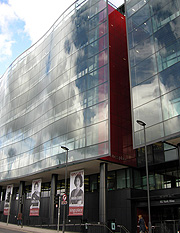
Exterior of Kings Place

The Royal Academy of Music's 'Music in Community' programme includes collaboration with artists not only in the music field but also in various genres of art. This article is about a workshop with a movement expert as the guest artist, in which the participants explored a story through two different artistic perspectives.
Title: RAM at Kings Place Family Workshop
Date: Saturday 10:00-15:00
Venue: Kings Place (90 York Way London N1 9AG)
Target: Families with children aged over 5
Host: The Royal Academy of Music/ Kings Place
Admission free, booking required
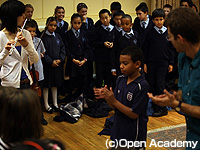
Image from school workshop
During that week, the Royal Academy of Music held various musical events at a new events venue in London, Kings Place, as part of a week-long residency programme. Saturday was devoted to a family workshop, and it was provided by 'Music in Community'. One of the features of 'Music in Community' is that it is keen to collaborate with artists who are active in various artistic fields (see No.2). This time, they invited a guest artist, Sabina, to act as the movement director.
Sabina led the physical expression part of the workshop, and Julian from the Academy led the musical part and the whole workshop. Academy students and graduates joined in as musicians: a pianist, a clarinetist, a violinist, a flutist, a cellist, an accordion player, a tuba player, a singer, and a composer. The theme for the day was a children's story by Hans Christian Andersen, entitled 'The Steadfast Tin Soldier'. A student composer, Elo, composed a piece of music based on the story, but intentionally left two sections blank so that the workshop participants could create music and movement to fill the gap.
The participants were families with children aged five and above. After introducing themselves, they started the workshop with a warm-up exercise led by Sabina. Associated with 'The Steadfast Tin Soldier', she included soldier-like movements, such as, marching in various directions, and moving with the arms and legs straight. Then, Julian led a voice activity, using various kinds of voices and lip movement. He also taught them a song, 'Face straight ahead, brave soldier. Shoulder the gun, brave soldier...'. They practiced singing it clearly and standing straight with a good posture, like soldiers.
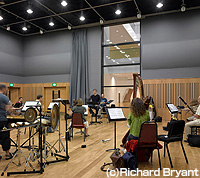
Workshop room at Kings Place
The participants split into two groups and created music and movement based on the story. Each group spent 45 minutes with Julian for the music workshop, and another 45 minutes with Sabina for the movement workshop. They swapped places half way through. They would perform the work in a concert at 2pm.
| 10:00-10:30 | Introduction, Warm-up exercise |
| 10:30-11:15 | Group1 Musical workshop / Group2 Movement workshop |
| 11:15-11:30 | Break |
| 11:30-12:15 | Group1 Movement workshop/ Group2 Musical workshop |
| 12:15-12:30 | Perform their pieces to each other |
| 12:30-13:10 | Lunch break |
| 13:10-14:00 | Rehearsal |
| 14:00-15:00 | Concert |
Group 1 had the music workshop first. When gathered, Julian told them the part of the story that they were in charge of: 'After everyone went to bed, toy dolls played war and partied. Tin soldiers were rattling in a box, wanting to join in. When a canary sang and announced the morning, the toys went back to their original place and went to sleep'.
Julian asked, 'How do you want to make this story into music?' One girl offered an idea, 'It starts quietly, because everyone is asleep. Then it gets louder and louder by adding instruments gradually, and at the end a canary sings, and the music suddenly stops'. He said, 'Sounds good. What kind of instrument would you like to start with? Try something'. She grabbed a triangle from the mountain of musical instruments, and played it quietly and slowly. When asked, 'What instrument do you want to play with?', she pointed to a violin.
To work out how to switch from a quiet scene to a loud party scene, they explored the sounds of the musical instruments in front of them, including the students' instruments. They exchanged their ideas and tried them out: 'While a triangle is playing a quiet sound, bells start to ring as if the toy box is rattling', 'Then, a tambourine and a tuba appear to be marching', 'A guiro, a wood block, drums, and a cello join in one by one, increasing the volume', 'When it comes to a climax, suddenly a piccolo plays the sound of a canary singing, and we all stop playing'.

Conduct an ensemble at school project
In the second half, group 1 had a movement workshop. The story was as follows: 'In the morning, the tin soldier with one leg was placed by the window. Suddenly, a strong wind opened the window, and the tin soldier fell outside the house. The children went out to look for him, but they could not find him. After it had rained, two boys found the tin soldier, made him a paper boat out of newspaper, and sailed it on the river. While the boat rocked up and down, the tin soldier stood firm on one foot'.
Holding that image, the participants explored their bodily movement and tried to tell the story like a pantomime. They went to the back of the stage and pretended to be asleep. The morning came and two adults stood up and formed a window with their bodies. When a boy made a gesture of putting the tin soldier by the window, a girl playing the role of the tin soldier stood by the window on one foot. Following the story, Sabina gave them the role on the spot, and supported them to create their movement. For example, they learnt that, by taking their time to spin and fall to the ground, the soldier could express the height off the window to the ground, which did not exist on stage.
The children and adults were actually good actors and actresses, following their instincts and directions from Sabina: When she said, 'The rain has stopped. Start playing!', the two boys started to play football; when she said, 'Look at that! I found a tin soldier!' or 'Let's make a paper boat!', the boys did a good pantomime reaction. Sabina's role was to inspire them by telling them what kind of scene it was, and to advise them where to stand, how to make use of the whole stage, and how to show their movements effectively to the audience. During the break, the children went to tell her happily about what they had created in the music workshop, what they were going to play, and how they had contributed to the ideas.
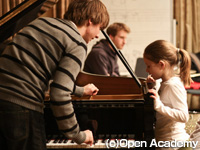
Another Family Day
After the break, the two groups performed their pieces to each other. For the first part of the story, group 1 created the music and group 2 created the movement, and vice versa for the second part of the story. They listened to the music and watched the movement which the other group has created, and imagined how it would fit into their work. Then, Julian and Sabina worked out how to perform them together, by adjusting the length of the music according to the movement, and adding marching movement for the marching music. The fathers also seemed to have fun with their children, jumping around the stage sword fighting and dodging their enemies.
In the afternoon, they rehearsed the two pieces, and performed them in front of the audience. Among their friends and family, the participants took their seats in the audience as well, and waited for the whole story to be revealed. The Academy students played the music that Elo had composed, and a narrator told the story along with the music. When it came to the scene which the participants were in charge of, they proceeded to the stage and performed the music and movement. They were proud of being part of the professional stage with other student musicians.
In addition to the two blank sections, there were other parts of the music where the participants could join in. When the theme of the tin soldiers came, Julian led the participants to stand up and sing the song which they had learnt at the beginning of the day. In the scene where the tin soldier was swallowed by a fish at sea, one of the children was encouraged to grab a fish toy and move it on the stage. The student musicians played their instruments when the toy fish came in front of them, improvising loudly or quietly according to the fish's movement. 'I want to do that, too!' Many of the children volunteered to do it.
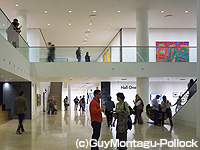
Interior of Kings Place
Although it was only a one-day workshop, they learnt a lot there; to create a piece and express themselves through music and movement based on the same story; to perform in coordination with the dynamics of the music or movement; to work in a group including both adults and children; to listen to the story and performance; and so on. Through approaching this activity from different points of view, and experiencing it by physically moving their bodies, they must have developed a deeper understanding of expression.
Report: Chigusa Futako
<< No.3|







